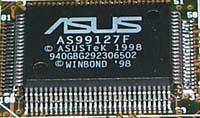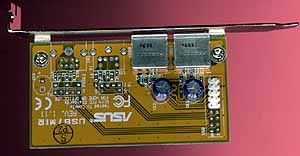The board does improve on a major layout problem that was present with the K7M: the ATX power supply connector is now placed on the opposite side of the memory banks so that it doesn't interfere with the installation of any larger heatsink/fan combos. While the amount of room present between the Slot-A connector and the memory banks isn't tremendous, at least the area you have to work with isn't obstructed.
Following VIA's recommendations as well as the lead of every single KX133 motherboard manufacturer to date, ASUS outfitted the K7V with VIA's 686A Super South Bridge that features an integrated I/O controller as well as an integrated PCI-ISA bridge, AC/MC'97 and hardware monitoring controllers. The beauty of the 686A Super South Bridge as we know from previous KX133 and Apollo Pro 133A reviews is that by integrating all of these functions into a single chip motherboard, manufacturers can save PCB space since they don't have to place more chips on the board. In the case of the K7V, with an already large PCB, the space saving benefits of the 686A are negated.
 Another
one of the benefits of the 686A is rendered useless by the on-board ASUS AS99127F
ASIC for hardware monitoring that can monitor 3 temperatures, 3 fan speeds,
and 6 voltages. ASUS included an external thermistor header by the Slot-A connector,
but supplied no thermistor for use with it. It would've made much more sense
for ASUS to use the cheaper 596B South Bridge controller if they were going
to use their own hardware monitoring controller and forego using a smaller PCB
for the board.
Another
one of the benefits of the 686A is rendered useless by the on-board ASUS AS99127F
ASIC for hardware monitoring that can monitor 3 temperatures, 3 fan speeds,
and 6 voltages. ASUS included an external thermistor header by the Slot-A connector,
but supplied no thermistor for use with it. It would've made much more sense
for ASUS to use the cheaper 596B South Bridge controller if they were going
to use their own hardware monitoring controller and forego using a smaller PCB
for the board.
One feature of the 686A Super South Bridge that was used is its support for 4 USB ports, as ASUS supplies an extra two USB connectors right out of the K7V's box.
The biggest issue we had with the K7V-RM was, because of its microATX form factor, the possibilities for expansion were very limited. The board itself featured no more than 3 PCI slots, an AGP slot and an AMR slot. The K7V builds upon its microATX counterpart's expandability by offering two more PCI slots, bringing the total up to 5 PCI slots, all of which are capable of accepting full length cards (if that doesn't seem important to you now, just wait until the release of the PCI Voodoo4/5 cards from 3dfx).
 In
addition to those five PCI slots, the board features the AMR slot which is driven
by the 686A Super South Bridge and an AGP Pro50 slot that has been popping up
on virtually all of the newer ASUS motherboards. While we have yet to see any
widely available video cards take advantage of the 25 - 50W AGP Pro50 specification,
having the slot doesn't harm anyone, and ASUS even went to the trouble of blocking
off the first 20 pins of the slot to prevent the accidental insertion of a regular
AGP card into the wrong section of the slot. Doing so would probably end up
frying your card since those upper 20 pins are mainly additional power pins,
so it's a well-needed safety precaution on ASUS' part.
In
addition to those five PCI slots, the board features the AMR slot which is driven
by the 686A Super South Bridge and an AGP Pro50 slot that has been popping up
on virtually all of the newer ASUS motherboards. While we have yet to see any
widely available video cards take advantage of the 25 - 50W AGP Pro50 specification,
having the slot doesn't harm anyone, and ASUS even went to the trouble of blocking
off the first 20 pins of the slot to prevent the accidental insertion of a regular
AGP card into the wrong section of the slot. Doing so would probably end up
frying your card since those upper 20 pins are mainly additional power pins,
so it's a well-needed safety precaution on ASUS' part.
The K7V, like the K7V-RM, features the Cirrus Logic CrystalClear SoundFusion CS4299 AC'97 codec that provides the CPU driven sound on-board. Luckily, the sound can be disabled from within the AWARD BIOS setup, but for system integrators, the software audio option makes for an easy way to include audio support for their low-cost systems. In terms of quality and performance, most AnandTech readers won't be too flattered by the integrated codec and will opt to use one of the three PCI slots for their own PCI sound card, but if this board is going to be the base for a second system then the integrated sound could save you a few bucks.
In order to supply a stable signal to the Athlon (something that is critical to the stable operation of any Athlon system since the Athlon draws so much power), ASUS outfitted the K7V with a handful of 1500uF and 680uF capacitors and even an oversized 4700uF cap.
Speaking of stability, the K7V was the most stable KX133 motherboard we've tested to date. It even outperformed the K7V-RM in our stability tests. While that was most likely due to the K7V-RM being an engineering sample, while our K7V is an actual retail board, the stability of the board is second to none.
Just like the previous Athlon motherboards from ASUS, the K7V features quite a few options for overclocking including support for a fairly wide range of FSB frequencies: 90 / 92 / 95 / 97 / 100 / 101 / 103 / 105 / 107 / 110 / 112 / 115 / 117 / 120 / 122 / 124 / 127 / 130 / 133 / 136 / 140 / 145 / 150 / 155MHz. Out of those, only the settings under 117MHz were of any use during our tests since anything higher wouldn't so much as boot. This isn't abnormal since it seems to be a limitation of the current implementation of the Athlon's EV6 bus by motherboard manufacturers.
The BIOS setup also allows you to set the DRAM to CPU frequency ratio as either 3:3 or 4:3, thus allowing you to run your memory at 133MHz while your FSB runs at 100MHz. In addition to FSB selection, the AWARD Medallion BIOS of the K7V lets you manually adjust the core voltage of your CPU, making the board even more flexible for overclockers. Both the FSB selection and core voltage selection can be accomplished through jumpers and dip switches located on the motherboard itself.
To top it all off, the K7V ships with a fairly detailed user's manual and a driver/utility CD that contains all of the drivers necessary to get your system up and running properly the first time.










0 Comments
View All Comments